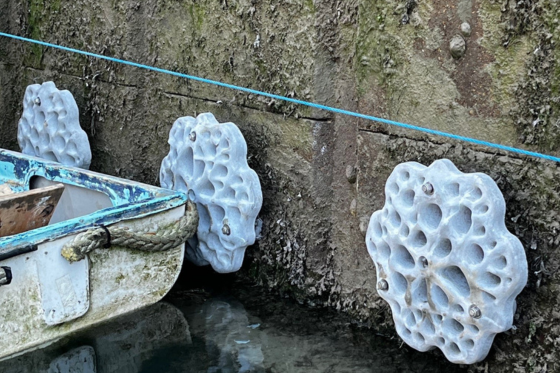Sustainability projects and partnerships
Living Seawalls
We have launched Living Seawalls, a new project promoting the growth of marine life within our local marinas.
The idea has been inspired by a program from the Sydney Institute of Marine Science who have designed and created large concrete tiles that attach to the smooth sea walls around Sydney Harbour. Our project will recreate these tiles on a smaller scale using a 3D printer and recycled printer filament, made in-house from old plastic bottles found on beaches and collected from schools.
We will be involving students from across the island, targeting primary school groups and GSCE students. The younger students will look at local creatures living around the coastline already. Combining their efforts with older students focusing on local rock formation and the design process, we should be able to create unique tiles that fit with the natural coastline and mimic a habitat that attracts further marine life to our marinas.
Along the journey, we will be inviting sponsorship from companies who are looking at offsetting their carbon emissions. With different sponsorship opportunities available and the large scalability of the project, it’s a great way to increase community engagement and get involved with local schools.
Bay of St Catherine seagrass protection initiative
The Bay of St Catherine supports a wealth of marine life; one of significant importance is the seagrass beds that have established in the area and reported to be the largest site around Jersey’s coastline.
Seagrass, along with being a vital nursery, provides shelter for marine fauna and at low water important feeding grounds for wildfowl and other birds. It is also recognised for its blue carbon, calculated to absorb carbon 35 times more than tropical rainforests.
Jersey’s hidden seagrass treasures – Blue Marine Foundation
Blue Carbon Resources: An Assessment of Jersey’s Territorial Seas (gov.je)
Studies have highlighted that traditional mooring systems and anchoring cause significant damage to the seagrass and erosion to the seabed by the mooring chain, damaging the benthic ecosystems within the vicinity.
Satellite imagery taken in July 2021, clearly indicates areas of erosion around moorings in the seagrass beds. The average area of damage caused by a mooring is 100m2 and the largest area identified is 350m2 (based on 2021 aerial image).
Our mission
Our mission is to ensure that we are protecting this special and biodiverse rich habitat allowing the seagrass meadow to flourish, not just for the here and now, but for future generations.
Project goals
The project goals are to ensure there is mutually beneficial management of the area through consistent and adaptive administration of moorings within the deep-water site and to afford protection for the marine environment encapsulated within this area through the following methods:
- Ensure all moorings are identified and accounted for
- Gradually reduce the overall number of moorings within the deep-water site
- Establish a no-anchoring zone and visitor moorings where possible
- Remove any unused moorings
- Protect the seagrass beds as a valuable habitat for many marine ecosystems and for its recognised ‘blue carbon’ status.
A working group has been established consisting of the following:
- Ports of Jersey
- Government of Jersey Marine Resources – Environment Department
- Jersey Marine Conservation
- Blue Marine Foundation
- St Catherine’s user group
Collectively working together with users of the bay to protect this valuable area.



